The Space-Based Solar Power Market is estimated to be valued at USD 3.3 billion in 2025 and is projected to reach USD 7.2 billion by 2035, registering a compound annual growth rate (CAGR) of 7.9% over the forecast period. This growth reflects a steady year-on-year expansion driven by increasing interest in orbital solar power solutions, advancements in satellite technology, and government initiatives supporting renewable energy innovations.
Between 2020 and 2024, the market experienced early adoption with incremental increases from USD 2.3 billion in 2020 to USD 3.1 billion in 2024, reflecting growing feasibility studies and pilot projects. From 2025 to 2030, the market enters a scaling phase, with revenue rising from USD 3.3 billion to approximately USD 4.5 billion. This period sees greater deployment of experimental power satellites, international collaborations, and initial commercial applications. Yearly growth during this phase averages around 8–9%, signaling robust investor confidence and technological maturation. In the consolidation phase from 2030 to 2035, revenue accelerates from USD 4.9 billion to USD 7.2 billion as large-scale commercial systems come online and operational efficiency improves.
Market expansion is supported by regulatory frameworks and increasing demand for sustainable energy sources in remote or space-reliant applications. By 2035, space-based solar power is positioned as a viable complement to terrestrial renewable energy, marking its transition from experimental technology to a scalable, commercially relevant solution.
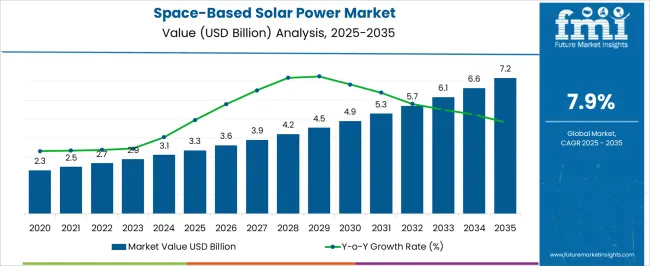
| Metric | Value |
|---|---|
| Space-Based Solar Power Market Estimated Value in (2025 E) | USD 3.3 billion |
| Space-Based Solar Power Market Forecast Value in (2035 F) | USD 7.2 billion |
| Forecast CAGR (2025 to 2035) | 7.9% |
The Space-Based Solar Power market is gaining traction as advancements in aerospace engineering and clean energy convergence begin to reshape global energy strategies. Current developments are centered around capturing solar energy in orbit and transmitting it to Earth using wireless power transmission systems. Recent updates from aerospace consortia and energy-tech firms suggest increased interest from national governments and defense organizations, driven by the promise of an uninterrupted power supply independent of terrestrial limitations.
Industry-focused news outlets and investor briefings have pointed to rising R&D funding and successful test demonstrations of beaming technologies as pivotal factors enhancing the market’s visibility. Future outlook appears strong as countries aim to reduce carbon footprints and achieve energy independence through high-efficiency, 24/7 solar power systems.
Innovations in ultra-light materials, formation flying satellites, and laser and microwave beam precision have further positioned space-based solar power as a credible part of long-term energy infrastructure.
The space-based solar power market is segmented by beam type, application, end use, and geographic regions. By beam type, the space-based solar power market is divided into Microwave power transmission and Laser beam power transmission. In terms of application, the space-based solar power market is classified into Electricity generation and Space applications.
Based on end use, the space-based solar power market is segmented into Government and defense and Commercial. Regionally, the space-based solar power industry is classified into North America, Latin America, Western Europe, Eastern Europe, Balkan & Baltic Countries, Russia & Belarus, Central Asia, East Asia, South Asia & Pacific, and the Middle East & Africa.
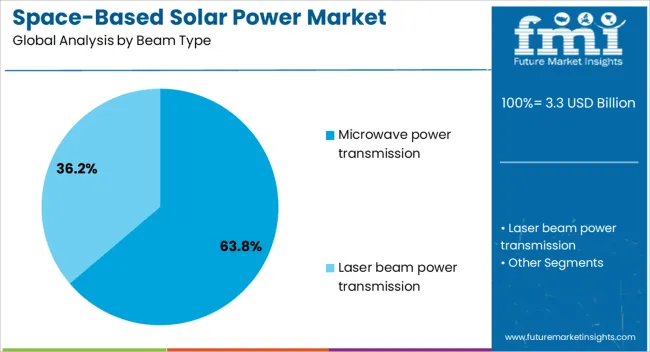
The microwave power transmission segment is expected to contribute 63.8% of the Space-Based Solar Power market revenue share in 2025, positioning it as the leading beam type. This dominance has been driven by the segment’s ability to deliver high-efficiency energy transfer over long distances with minimal atmospheric interference. The preference for microwave systems has been strengthened by their proven stability during demonstration missions and compatibility with satellite-based infrastructure.
Industry sources indicate that microwave frequencies enable focused energy beaming with reduced dispersion, which is critical for transmission from orbit to ground. Governmental space programs and defense agencies have supported initiatives involving microwave beam systems due to their feasibility, safety profile, and scalability.
This segment’s leadership has been further reinforced by advancements in antenna design, rectennas, and energy conversion systems that improve transmission performance. As public and private sectors continue to invest in large-scale orbital solar stations, microwave-based systems are expected to remain the primary method of power delivery.
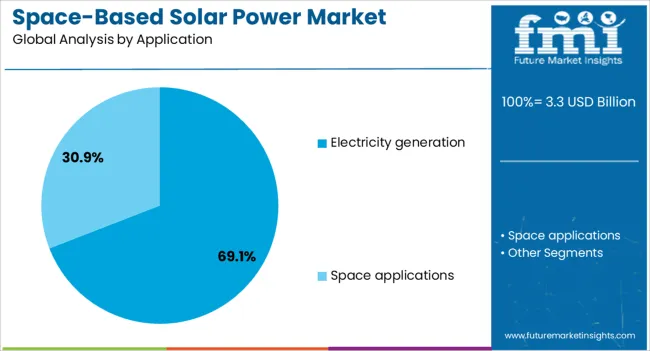
The electricity generation application segment is projected to hold 69.1% of the Space-Based Solar Power market revenue share in 2025, establishing it as the most dominant application area. The core purpose of space-based solar infrastructure has been centered on delivering clean, constant electricity, especially in regions lacking consistent terrestrial solar exposure. The segment’s growth has been shaped by energy policy shifts favoring renewable alternatives that bypass geographic and climatic limitations.
Technical documentation from satellite manufacturers and press statements from energy consortiums have underscored electricity generation as the primary focus of space-based solar missions. Its dominance has also been attributed to the increasing demand for decentralized, off-grid energy access, particularly in remote or disaster-prone zones.
As space-based platforms enable continuous solar harvesting regardless of Earth’s day-night cycles, electricity generation has become the most economically and strategically viable use case.

The government and defense segment is anticipated to capture 56.7% of the Space-Based Solar Power market revenue share in 2025, making it the largest end-use segment. This leadership is being reinforced by increasing national-level investments in secure and resilient energy solutions capable of supporting mission-critical operations. Defense agencies have emphasized the importance of independent, 24/7 power supply that is unaffected by geopolitical instability or terrestrial infrastructure vulnerabilities.
Official statements and agency-level research publications have highlighted the strategic advantage of deploying space-based solar systems for remote bases and emergency scenarios. The government sector has been actively funding pilot programs and collaborations with aerospace contractors to evaluate system readiness and deployment potential.
Furthermore, public-sector involvement is helping shape international standards and regulatory frameworks, enabling the future scale-up of commercial use. These efforts have underpinned the segment’s sustained growth, positioning it as a central force in driving forward early adoption and market maturity.
The space-based solar power (SBSP) market is emerging as a solution to provide continuous, large-scale renewable energy by harvesting solar power in space and transmitting it to Earth. Growing energy demand, interest in clean energy alternatives, and advancements in satellite technology are driving exploration of this sector. Key applications include providing stable energy to remote regions, disaster recovery, and supplementing terrestrial grids. Governments, space agencies, and private companies are investing in research, prototypes, and pilot projects to establish feasibility and commercial viability.
SBSP relies on solar arrays in orbit to capture sunlight uninterrupted by weather or night cycles. Innovations in lightweight solar panels, wireless power transmission, and high-efficiency rectennas improve energy conversion and delivery. Research focuses on minimizing transmission losses and ensuring safe energy beam targeting on Earth. Effective deployment requires orbital station maintenance, satellite durability, and long-term operational reliability. As these technologies mature, the efficiency and economic feasibility of SBSP increase, making it a more attractive alternative to conventional energy sources for regions with limited infrastructure or high electricity demand.
Space-based solar power presents opportunities for remote and islanded regions lacking reliable electricity. SBSP can supplement terrestrial grids during peak demand or emergencies. Its ability to deliver continuous, high-quality energy without dependence on fossil fuels makes it attractive for military bases, research stations, and disaster-prone areas. Governments and private entities are exploring partnerships to integrate SBSP with energy storage systems and existing power infrastructure. This market segment can stimulate regional development, reduce reliance on imported fuels, and improve energy security in isolated areas, providing long-term strategic benefits.
Major growth in SBSP depends on collaboration between governments, space agencies, and private aerospace companies. Joint ventures and public-private partnerships facilitate funding, technology sharing, and pilot deployment. Investment in launch systems, in-orbit assembly, and long-term maintenance infrastructure is critical for commercialization. Competitive advantage relies on intellectual property in transmission, satellite control, and energy collection technologies. International cooperation reduces costs and accelerates adoption, while regulatory alignment ensures safe operation. Countries with space capabilities are actively participating in research and demonstration projects, laying the groundwork for a new global energy market.
High initial capital expenditure, launch costs, and in-orbit construction complexity limit rapid SBSP deployment. Technical challenges include ensuring uninterrupted energy transmission, orbital debris mitigation, and satellite longevity. Regulatory approval for wireless power transmission, frequency allocation, and cross-border energy delivery adds complexity. Maintaining safety for both terrestrial populations and space operations is critical. Companies must balance R&D investments, risk management, and scalability to achieve commercial viability. Until costs decrease and operational reliability improves, large-scale adoption of space-based solar power remains constrained, though pilot projects continue to provide valuable data and validation.
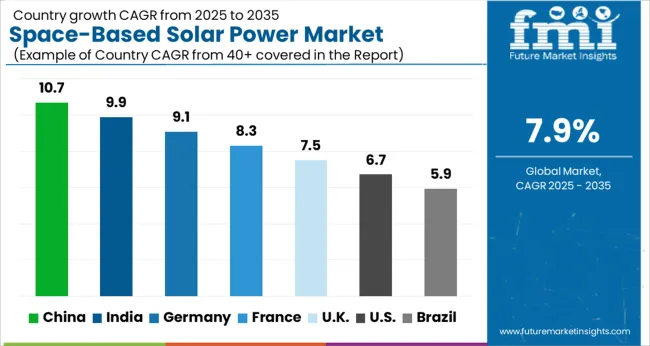
The global space-based solar power market is projected to grow at a CAGR of 7.9%, driven by the increasing focus on renewable energy solutions and space-based energy technologies. China leads the market with a 10.7% growth rate, supported by ambitious space energy projects and technological advancements. India follows at 9.9%, propelled by investments in innovative energy and satellite programs. Germany shows steady growth at 9.1%, leveraging research in space energy and renewable integration. The UK and USA record growth rates of 7.5% and 6.7%, respectively, reflecting ongoing exploration of space-based solar power applications. This report includes insights on 40+ countries; the top countries are shown here for reference.
The space-based solar power market in China is expanding at 10.7%, driven by government investment in renewable energy technologies and ambitious plans for space-based energy infrastructure. China is exploring satellite-based solar energy systems to capture solar power from space and transmit it to Earth using microwave or laser technology. This approach aims to provide continuous, large-scale energy generation independent of weather or day-night cycles, enhancing energy security and supporting the nation’s renewable energy goals. Domestic research institutions and private companies are actively developing advanced space solar panels, wireless power transmission technologies, and orbital platforms. Growing energy demand, combined with strategic investments in aerospace and clean energy, positions China as a key player in the space-based solar power market. The country’s focus on innovation, scalability, and international collaborations is expected to drive long-term growth in this futuristic energy sector.
The space-based solar power market in India is growing at 9.9%, fueled by increasing interest in innovative renewable energy solutions and government initiatives supporting solar energy research. India is exploring satellite-based solar systems capable of transmitting energy to ground stations, offering continuous power generation that complements terrestrial solar plants. Research organizations and technology startups are developing high-efficiency space solar panels, power beaming technologies, and orbital platforms to advance this sector. The market growth is also supported by India’s ambitious renewable energy targets and its commitment to achieving net-zero emissions by 2070. By integrating space-based solar power with existing energy infrastructure, India aims to enhance energy security and meet rising electricity demands. This futuristic energy solution is expected to attract further investments, international collaborations, and technological advancements, strengthening India’s position in the global space-based solar power market.
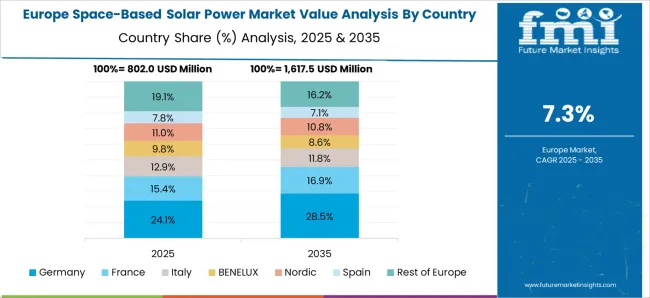
Space-based solar power market in Germany is expanding at 9.1%, supported by research institutions, renewable energy initiatives, and a commitment to sustainable energy solutions. Germany is exploring space-based solar energy as a complementary source to terrestrial solar and wind power, enabling continuous energy generation regardless of weather or daylight. Government-funded programs and private research entities are focusing on the development of high-efficiency solar panels, satellite platforms, and wireless power transmission technologies. The country’s emphasis on clean energy, smart grid integration, and energy security drives interest in this futuristic energy solution. Technological advancements in orbital solar systems and international collaborations enhance Germany’s capabilities in space-based energy research. As global demand for reliable renewable energy grows, Germany’s market for space-based solar power is expected to witness steady growth, offering opportunities for innovation and leadership in advanced energy technologies.
The space-based solar power market in the United Kingdom is growing at 7.5%, driven by government research initiatives and private sector exploration of satellite-based solar technologies. The UK aims to develop systems capable of capturing solar energy in space and transmitting it to terrestrial receivers, providing continuous renewable energy and enhancing energy security. Investment in orbital solar panels, power beaming, and satellite platform technologies is increasing as the country focuses on achieving net-zero emissions targets. Collaborative programs with international space and energy agencies are also contributing to technological advancements. Rising electricity demand, sustainability commitments, and the potential for uninterrupted energy generation support the UK’s interest in space-based solar power. The market is expected to expand steadily as research progresses and pilot projects demonstrate feasibility for large-scale implementation.
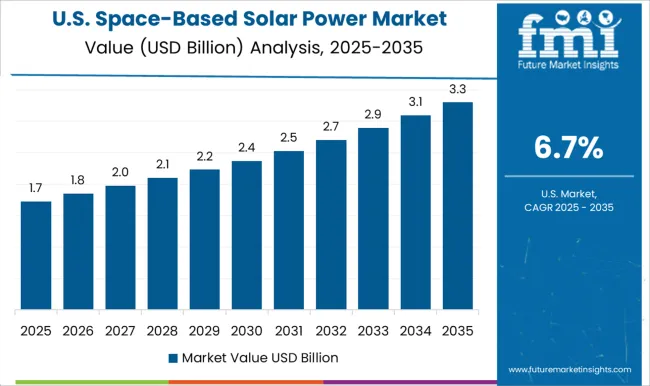
The space-based solar power market in the United States is growing at 6.7%, driven by federal and private investments in space-based energy systems and renewable energy research. The USA is developing satellite solar technologies that can beam energy to Earth, providing reliable, continuous power regardless of terrestrial conditions. NASA, private aerospace companies, and energy startups are investing in high-efficiency space solar panels, orbital platforms, and wireless power transmission solutions. National initiatives to enhance energy security, achieve clean energy targets, and reduce dependence on fossil fuels further accelerate market growth. Technological advancements and pilot projects are validating the feasibility of large-scale space-based solar power, attracting additional funding and partnerships. The USA market is expected to expand steadily as space-based solar power moves from research to practical deployment, offering opportunities for innovation and commercialization.
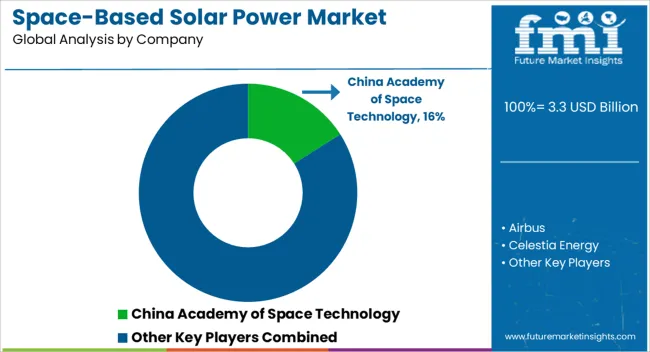
Key players in the market include China Academy of Space Technology, a pioneer in satellite and space-based energy technologies, and Airbus, which focuses on developing orbital solar power systems with efficient energy transmission capabilities. Celestia Energy and Metasat are advancing the commercialization of space solar power by developing satellite platforms and wireless power transfer technologies. Japan Aerospace Exploration Agency (JAXA) is exploring SBSP prototypes to demonstrate practical energy generation and transmission from orbit. Northrop Grumman and Thales Alenia Space contribute with satellite manufacturing, deployment solutions, and advanced space systems integration. Emerging innovators like Emrod, Sirin Orbital Systems, and SpaceTech are focused on wireless energy transmission, modular satellite designs, and cost-effective launch solutions, accelerating the feasibility of SBSP projects. As technological maturity improves and launch costs decrease, the SBSP market is expected to expand rapidly, offering a sustainable, reliable, and scalable energy source. The convergence of aerospace engineering, renewable energy innovation, and global sustainability initiatives positions space-based solar power as a potentially pivotal solution in meeting future energy demands.
| Item | Value |
|---|---|
| Quantitative Units | USD 3.3 Billion |
| Beam Type | Microwave power transmission and Laser beam power transmission |
| Application | Electricity generation and Space applications |
| End Use | Government and defense and Commercial |
| Regions Covered | North America, Europe, Asia-Pacific, Latin America, Middle East & Africa |
| Country Covered | United States, Canada, Germany, France, United Kingdom, China, Japan, India, Brazil, South Africa |
| Key Companies Profiled | China Academy of Space Technology, Airbus, Celestia Energy, Emrod, Japan Aerospace Exploration Agency, Metasat, Northrop Grumman, Sirin Orbital Systems, SpaceTech, and Thales Alenia Space |
| Additional Attributes | Dollar sales by type including photovoltaic arrays, microwave transmitters, and rectenna systems, application across satellite power generation, remote energy supply, and space exploration missions, and region covering North America, Europe, and Asia-Pacific. Growth is driven by rising demand for continuous renewable energy, advancements in space technology, and increasing investment in sustainable power solutions. |
The global space-based solar power market is estimated to be valued at USD 3.3 billion in 2025.
The market size for the space-based solar power market is projected to reach USD 7.2 billion by 2035.
The space-based solar power market is expected to grow at a 7.9% CAGR between 2025 and 2035.
The key product types in space-based solar power market are microwave power transmission and laser beam power transmission.
In terms of application, electricity generation segment to command 69.1% share in the space-based solar power market in 2025.






Full Research Suite comprises of:
Market outlook & trends analysis
Interviews & case studies
Strategic recommendations
Vendor profiles & capabilities analysis
5-year forecasts
8 regions and 60+ country-level data splits
Market segment data splits
12 months of continuous data updates
DELIVERED AS:
PDF EXCEL ONLINE
Solar Analyzer Market Size and Share Forecast Outlook 2025 to 2035
Solar Aluminum Alloy Frame Market Size and Share Forecast Outlook 2025 to 2035
Solar Grade Monocrystalline Silicon Rods Market Analysis - Size, Share, and Forecast Outlook 2025 to 2035
Solar Vehicle Market Size and Share Forecast Outlook 2025 to 2035
Solar PV Module Market Size and Share Forecast Outlook 2025 to 2035
Solar Encapsulation Market Size and Share Forecast Outlook 2025 to 2035
Solar Pumps Market Analysis - Size, Share, and Forecast Outlook 2025 to 2035
Solar Mobile Light Tower Market Size and Share Forecast Outlook 2025 to 2035
Solar PV Recycling Market Size and Share Forecast Outlook 2025 to 2035
Solar Panel Market Size and Share Forecast Outlook 2025 to 2035
Solar Panel Recycling Management Market Size and Share Forecast Outlook 2025 to 2035
Solar Photovoltaic (PV) Market Size and Share Forecast Outlook 2025 to 2035
Solar EPC Market Size and Share Forecast Outlook 2025 to 2035
Solar Panel Cleaning Market Size and Share Forecast Outlook 2025 to 2035
Solar Salt Market Size and Share Forecast Outlook 2025 to 2035
Solar Control Window Films Market Size and Share Forecast Outlook 2025 to 2035
Solar Street Lighting Market Size and Share Forecast Outlook 2025 to 2035
Solar Reflective Glass Market Size and Share Forecast Outlook 2025 to 2035
Solar Water Desalination Plant Market Size and Share Forecast Outlook 2025 to 2035
Solar Water Heater Market Size and Share Forecast Outlook 2025 to 2035

Thank you!
You will receive an email from our Business Development Manager. Please be sure to check your SPAM/JUNK folder too.
Chat With
MaRIA